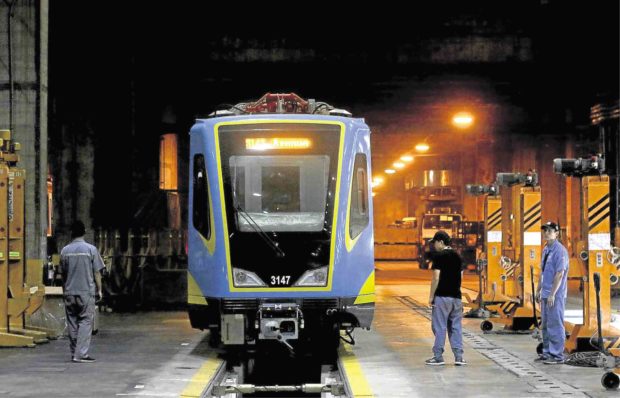First Dalian train ready for regular run

NEWEST ADDITION A Dalian train will finally make its debut on the MRT 3 revenue line. —INQUIRER FILE PHOTO
With the 26-month-long intensive Metro Rail Transit (MRT) 3 rehabilitation program already under way, the Department of Transportation (DOTr) is eyeing the deployment anytime this week of a Dalian train, the first one to join the regular fleet.
The newest addition to the MRT 3 revenue line is the first of only three Dalian trains that have so far completed validation tests after years of sitting unused in the light rail system’s depot over alleged incompatibility issues.
Earlier, the three China-made trains, out of 18 that were delivered to the country, also underwent a 1,000-kilometer commissioning test. This was just one of several set by the DOTr to determine their operability and compatibility with the tracks, Transport Undersecretary TJ Batan told the Inquirer.
While their performance was generally satisfactory and they were “conditionally qualified” to operate, Batan said fully clearing the new trains of all issues was still dependent on the progress of the MRT 3’s rehabilitation program.
Operating trains still at 15
Batan also pointed out that the addition of the Dalian train to the MRT 3’s regular fleet would not necessarily ease congestion since the average number of operating trains would remain at 15.
The new train, he explained, would only help fill the gap while the old rolling stocks were being overhauled.
Moreover, the three Dalian trains that had passed the first validation test would have to undergo a second one with the completion of the rehabilitation program, Batan said.
“We need to test the trains at their [true] operational conditions, meaning, at 60 kilometers per hour,” he added. “But we can’t do that because we have a speed restriction [of 30 kph].”
“We have some observations [about the Dalian trains’ operations]… but many of these observations are attributable to the rails’ condition,” Batan said.
He stressed anew the need to overhaul the MRT 3’s tracks, the most battered part of the rail system.
Amid a budget impasse in Congress, the MRT 3’s maintenance and service provider, Sumitomo-Heavy Industries, had to shoulder the costs of buying the new rails, spare parts and signaling system needed for the P21-billion rehabilitation project.
Partly funded by Japan
The procurement of spare parts was the first phase of the project that would be partially funded by an P18-billion loan from Japan. The rest would be shouldered by the Philippine government.
The rehabilitation will also cover the MRT 3’s periodic maintenance, including the restoration and overhaul of the line’s power supply, overhead catenary system, signaling system, tracks, closed-circuit television camera and public address systems, as well as its elevators and escalators.